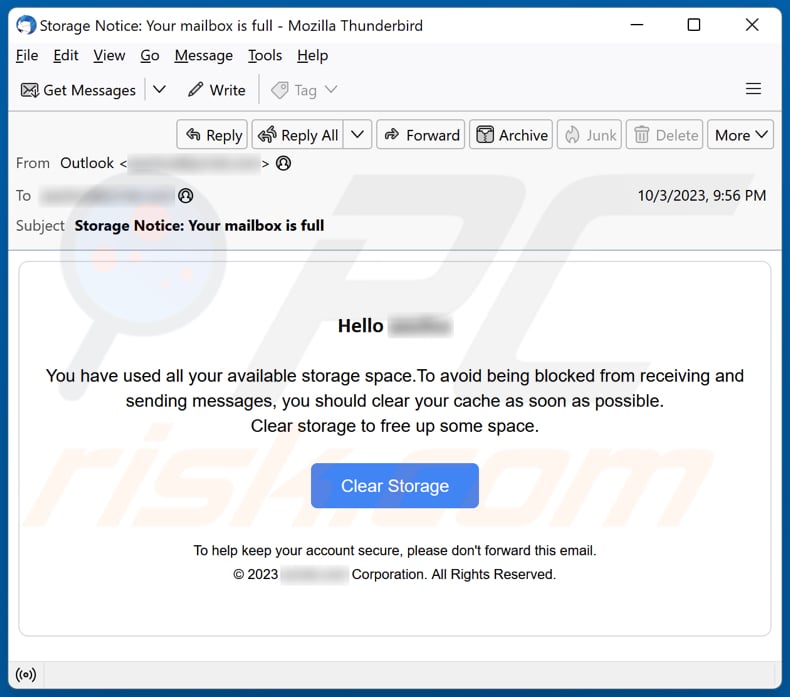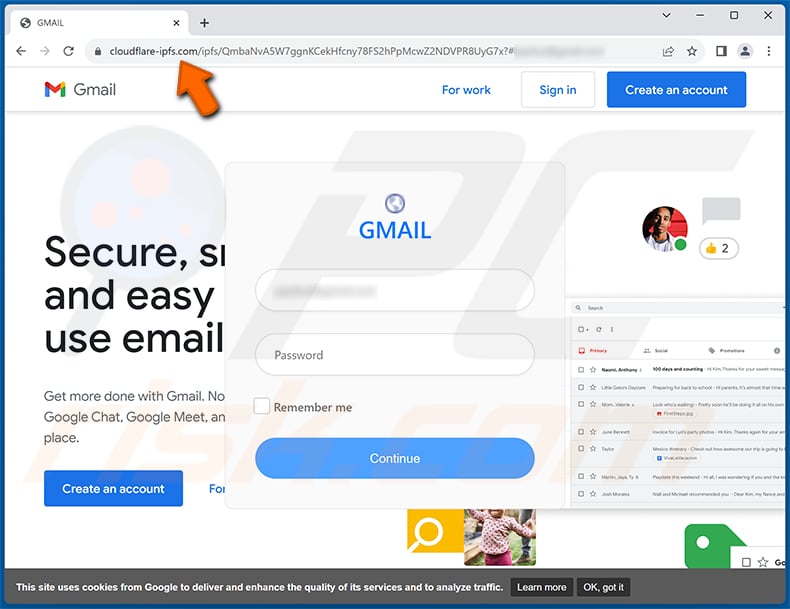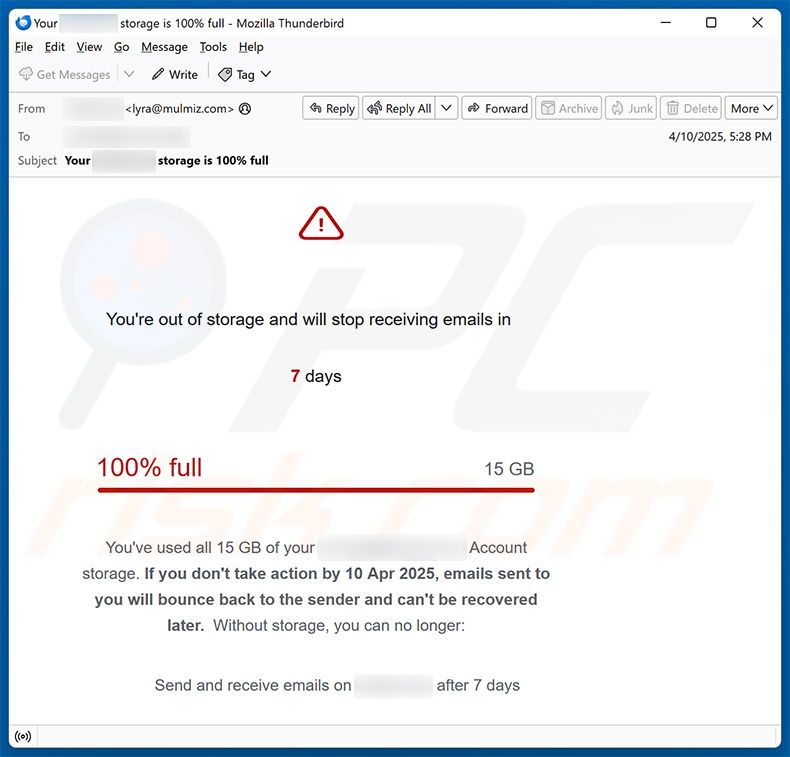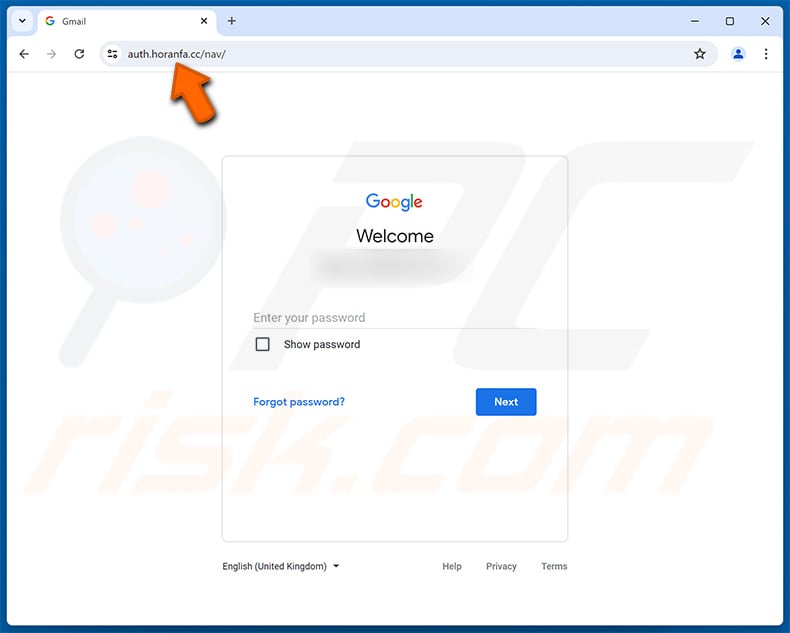How to spot fake letters like "You Have Used All Your Available Storage Space"
Phishing/ScamAlso Known As: You Have Used All Your Available Storage Space phishing campaign
Get free scan and check if your device is infected.
Remove it nowTo use full-featured product, you have to purchase a license for Combo Cleaner. Seven days free trial available. Combo Cleaner is owned and operated by RCS LT, the parent company of PCRisk.com.
What is "You Have Used All Your Available Storage Space"?
Upon examination, it has been found that this email is a phishing scam. Those behind this scam campaign aim to lure recipients into sharing sensitive information via a fraudulent webpage. Consequently, it is strongly recommended to ignore and not respond to this email or similar ones.

More about the "You Have Used All Your Available Storage Space" scam email
In this phishing email, the subject line mentions a storage notice, alerting recipients that their mailbox is purportedly full. The email claims that recipients have exhausted their available storage space and urgently encourages them to clear their cache to prevent potential blockage from sending or receiving messages.
The email includes the "Clear Storage" button and concludes with a reminder not to forward the email for security reasons. Clicking the "Clear Storage" button (link) leads to a counterfeit sign-in page for an email service provider.
This deceptive page adapts its design to match the recipient's email address, mimicking the appearance of the authentic sign-in page associated with the recipient's email provider. For instance, if the recipient uses Gmail, the fraudulent page will appear as a convincing replica of the Gmail sign-in page.
The purpose of this phishing campaign is to extract email account login credentials from unsuspecting recipients. With access to a victim's email account, scammers can hijack the account, change passwords, and lock out the legitimate owner. This allows them to control the email, send malicious messages, or conduct other fraudulent activities.
Furthermore, stolen emails may contain sensitive or compromising content that scammers can use to extort money or threaten victims. Also, scammers may use stolen credentials in credential stuffing attacks, testing if the same login details work on multiple online services. Successful logins grant access to additional accounts and data.
| Name | You Have Used All Your Available Storage Space Email Scam |
| Threat Type | Phishing, Scam, Social Engineering, Fraud |
| Fake Claim | You have used all your available storage space. |
| Disguise | Notification from email service provider |
| Symptoms | Unauthorized online purchases, changed online account passwords, identity theft, illegal access of the computer. |
| Distribution methods | Deceptive emails, rogue online pop-up ads, search engine poisoning techniques, misspelled domains. |
| Damage | Loss of sensitive private information, monetary loss, identity theft. |
| Malware Removal (Windows) |
To eliminate possible malware infections, scan your computer with legitimate antivirus software. Our security researchers recommend using Combo Cleaner. Download Combo CleanerTo use full-featured product, you have to purchase a license for Combo Cleaner. 7 days free trial available. Combo Cleaner is owned and operated by RCS LT, the parent company of PCRisk.com. |
Similar scam emails in general
Phishing emails typically request sensitive information like login credentials, credit card numbers, or social security details under the guise of a legitimate request or emergency. They often display deceptive sender names or addresses, attempting to mimic legitimate sources, such as well-known companies, banks, or government agencies.
They commonly include links to fraudulent websites or malicious attachments, enticing recipients to click or download files that can lead to malware infections or data theft. Some examples of phishing campaigns are "Switch To New Version", "Cloud Voicemail", "SecureMailBox - Account Reconfirmation".
How do spam campaigns infect computers?
When recipients open attachments in emails sent by threat actors, they expose their computers to potential malware installations. Sometimes, emails may persuade recipients to enable macros in attached documents, a step that can activate malicious scripts and lead to an infection.
Moreover, interacting with malicious links embedded in emails can redirect recipients to malicious websites. These websites may employ tactics like drive-by downloads or social engineering to introduce malware into systems.
How to avoid installation of malware?
Maintaining a vigilant approach is crucial when dealing with email attachments and links, especially if you are unfamiliar with the sender or detect any suspicious elements in the email. It is also advisable to avoid interactions with advertisements from untrustworthy sources and refrain from visiting questionable websites.
To ensure the continual security of your system, make it a practice to routinely update your operating system, applications, and web browsers. When obtaining files and programs, rely exclusively on reputable sources like official websites or app stores. Enhance your computer's protection by installing reliable antivirus or anti-malware software.
If you have already opened malicious attachments, we recommend running a scan with Combo Cleaner Antivirus for Windows to automatically eliminate infiltrated malware.
Text presented in the "You Have Used All Your Available Storage Space" email letter:
Subject: Storage Notice: Your mailbox is full
Hello ********
You have used all your available storage space.To avoid being blocked from receiving and sending messages, you should clear your cache as soon as possible.
Clear storage to free up some space.
Clear StorageTo help keep your account secure, please don't forward this email.
© 2023 ******** Corporation. All Rights Reserved.
Phishing website promoted via this scam:

Another variant of an email from "You Have Used All Your Available Storage Space" spam campaign:

Text presented within:
Subject: Your ******** storage is 100% full
You're out of storage and will stop receiving emails in 7 days
100% full 15 GBYou've used all 15 GB of your ******** Account storage. If you don't take action by 10 Apr 2025, emails sent to you will bounce back to the sender and can't be recovered later. Without storage, you can no longer:
Send and receive emails on ******** after 7 daysGet more storage
Not ready to get more storage?
Clean up space
We are One of a membership that offers expanded storage and additional member benefits* – all in one shareable plan.
Screenshot of the promoted phishing site:

Instant automatic malware removal:
Manual threat removal might be a lengthy and complicated process that requires advanced IT skills. Combo Cleaner is a professional automatic malware removal tool that is recommended to get rid of malware. Download it by clicking the button below:
DOWNLOAD Combo CleanerBy downloading any software listed on this website you agree to our Privacy Policy and Terms of Use. To use full-featured product, you have to purchase a license for Combo Cleaner. 7 days free trial available. Combo Cleaner is owned and operated by RCS LT, the parent company of PCRisk.com.
Quick menu:
- What is You Have Used All Your Available Storage Space phishing campaign?
- Types of malicious emails.
- How to spot a malicious email?
- What to do if you fell for an email scam?
Types of malicious emails:
![]() Phishing Emails
Phishing Emails
Most commonly, cybercriminals use deceptive emails to trick Internet users into giving away their sensitive private information, for example, login information for various online services, email accounts, or online banking information.
Such attacks are called phishing. In a phishing attack, cybercriminals usually send an email message with some popular service logo (for example, Microsoft, DHL, Amazon, Netflix), create urgency (wrong shipping address, expired password, etc.), and place a link which they hope their potential victims will click on.
After clicking the link presented in such email message, victims are redirected to a fake website that looks identical or extremely similar to the original one. Victims are then asked to enter their password, credit card details, or some other information that gets stolen by cybercriminals.
![]() Emails with Malicious Attachments
Emails with Malicious Attachments
Another popular attack vector is email spam with malicious attachments that infect users' computers with malware. Malicious attachments usually carry trojans that are capable of stealing passwords, banking information, and other sensitive information.
In such attacks, cybercriminals' main goal is to trick their potential victims into opening an infected email attachment. To achieve this goal, email messages usually talk about recently received invoices, faxes, or voice messages.
If a potential victim falls for the lure and opens the attachment, their computers get infected, and cybercriminals can collect a lot of sensitive information.
While it's a more complicated method to steal personal information (spam filters and antivirus programs usually detect such attempts), if successful, cybercriminals can get a much wider array of data and can collect information for a long period of time.
![]() Sextortion Emails
Sextortion Emails
This is a type of phishing. In this case, users receive an email claiming that a cybercriminal could access the webcam of the potential victim and has a video recording of one's masturbation.
To get rid of the video, victims are asked to pay a ransom (usually using Bitcoin or another cryptocurrency). Nevertheless, all of these claims are false - users who receive such emails should ignore and delete them.
How to spot a malicious email?
While cyber criminals try to make their lure emails look trustworthy, here are some things that you should look for when trying to spot a phishing email:
- Check the sender's ("from") email address: Hover your mouse over the "from" address and check if it's legitimate. For example, if you received an email from Microsoft, be sure to check if the email address is @microsoft.com and not something suspicious like @m1crosoft.com, @microsfot.com, @account-security-noreply.com, etc.
- Check for generic greetings: If the greeting in the email is "Dear user", "Dear @youremail.com", "Dear valued customer", this should raise suspiciousness. Most commonly, companies call you by your name. Lack of this information could signal a phishing attempt.
- Check the links in the email: Hover your mouse over the link presented in the email, if the link that appears seems suspicious, don't click it. For example, if you received an email from Microsoft and the link in the email shows that it will go to firebasestorage.googleapis.com/v0... you shouldn't trust it. It's best not to click any links in the emails but to visit the company website that sent you the email in the first place.
- Don't blindly trust email attachments: Most commonly, legitimate companies will ask you to log in to their website and to view any documents there; if you received an email with an attachment, it's a good idea to scan it with an antivirus application. Infected email attachments are a common attack vector used by cybercriminals.
To minimise the risk of opening phishing and malicious emails we recommend using Combo Cleaner Antivirus for Windows.
Example of a spam email:

What to do if you fell for an email scam?
- If you clicked on a link in a phishing email and entered your password - be sure to change your password as soon as possible. Usually, cybercriminals collect stolen credentials and then sell them to other groups that use them for malicious purposes. If you change your password in a timely manner, there's a chance that criminals won't have enough time to do any damage.
- If you entered your credit card information - contact your bank as soon as possible and explain the situation. There's a good chance that you will need to cancel your compromised credit card and get a new one.
- If you see any signs of identity theft - you should immediately contact the Federal Trade Commission. This institution will collect information about your situation and create a personal recovery plan.
- If you opened a malicious attachment - your computer is probably infected, you should scan it with a reputable antivirus application. For this purpose, we recommend using Combo Cleaner Antivirus for Windows.
- Help other Internet users - report phishing emails to Anti-Phishing Working Group, FBI’s Internet Crime Complaint Center, National Fraud Information Center and U.S. Department of Justice.
Frequently Asked Questions (FAQ)
Why did I receive this email?
Criminals send identical messages to thousands of recipients, hoping that at least one individual will be deceived. These spam emails lack personalization and are generic in nature.
I have provided my personal information when tricked by this email, what should I do?
Without delay, reset the passwords for any accounts where you have disclosed information, particularly those connected to financial or sensitive data. Additionally, promptly report the phishing attempt to your email service provider.
I have downloaded and opened a file attached to an email, is my computer infected?
When dealing with files, the risk of infection is notably high if the file is an executable (.exe). However, with file types like .pdf or .doc, there is a possibility that you may have avoided infection since merely opening such documents in some cases might not be enough for malware to compromise your computer.
I have read the email but did not open the attachment, is my computer infected?
Opening an email by itself does not carry any inherent risk. System infections typically occur when users interact with the email by clicking on links within it or opening attached files.
Will Combo Cleaner remove malware infections that were present in email attachment?
Combo Cleaner has the capability to identify and eradicate the majority of well-known malware infections. Sophisticated malware can hide itself deeply within the system. As a precautionary measure, performing a comprehensive system scan is vital to guarantee the detection and removal of any potential threats.
Share:

Tomas Meskauskas
Expert security researcher, professional malware analyst
I am passionate about computer security and technology. I have an experience of over 10 years working in various companies related to computer technical issue solving and Internet security. I have been working as an author and editor for pcrisk.com since 2010. Follow me on Twitter and LinkedIn to stay informed about the latest online security threats.
PCrisk security portal is brought by a company RCS LT.
Joined forces of security researchers help educate computer users about the latest online security threats. More information about the company RCS LT.
Our malware removal guides are free. However, if you want to support us you can send us a donation.
DonatePCrisk security portal is brought by a company RCS LT.
Joined forces of security researchers help educate computer users about the latest online security threats. More information about the company RCS LT.
Our malware removal guides are free. However, if you want to support us you can send us a donation.
Donate
▼ Show Discussion